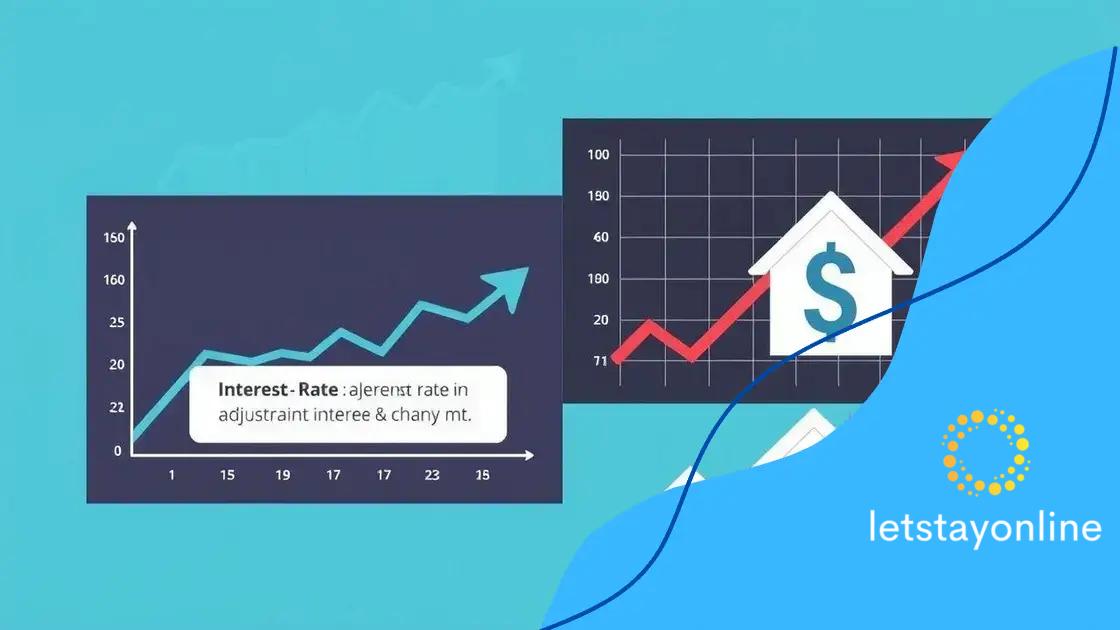Fed considers interest rate changes: what it means for you

Interest rates directly affect loans and savings, as increases raise borrowing costs, while lower rates encourage spending and investment, making financial management essential during rate shifts.
Fed considers interest rate changes that may ripple through the economy, affecting everything from your mortgage to savings accounts. Are you prepared for what’s next?
Understanding the Fed’s role in interest rates
The Federal Reserve, often referred to as the Fed, plays a vital role in influencing interest rates in the United States. Understanding this role can help you grasp how monetary policy affects your finances.
The Fed establishes the target federal funds rate, which is the interest rate at which banks lend to each other overnight. By raising or lowering this rate, the Fed can influence overall economic activity. If the economy is booming, the Fed might increase rates to prevent inflation. Conversely, if the economy is sluggish, the Fed may lower rates to stimulate growth.
Key Functions of the Fed
Here are some of the core responsibilities of the Federal Reserve:
- Setting monetary policy
- Regulating banks
- Maintaining financial stability
- Providing financial services to the government
These functions are crucial as they help control money supply and credit availability in the economy. When the Fed adjusts interest rates, it can impact consumer borrowing, business investments, and overall economic health.
Changes in interest rates ripple through the economy, affecting everything from mortgages to credit card rates. For instance, when rates are low, borrowing costs decrease, encouraging people to take loans for big purchases like homes or cars. This, in turn, can boost spending and economic growth.
Recent Decisions and Their Impact
Recently, the Fed has faced challenges in balancing economic growth with inflation control. Adjustments to interest rates are carefully analyzed, considering both domestic and global factors. Each decision is made by the Federal Open Market Committee (FOMC), which meets regularly to discuss the economic outlook.
As you can see, the Fed’s management of interest rates not only guides the economy but also significantly influences your financial decisions. Staying informed about the Fed’s actions can help you make smarter choices in your personal finances.
Recent trends in interest rate adjustments

Recent trends in interest rate adjustments have shown a dynamic response to the evolving economic landscape. By analyzing current patterns, we can uncover how these changes impact consumers and businesses alike.
The Federal Reserve has been actively adjusting interest rates to address various economic concerns. When inflation rises, the Fed typically increases rates to keep prices in check. Conversely, when the economy slows, they may lower rates to encourage borrowing and spending.
Current Interest Rate Environment
In recent months, several key trends have emerged:
- Gradual increases in rates to combat inflation
- A focus on long-term economic stability
- Close monitoring of unemployment rates
- Adjustments based on global economic conditions
These trends reflect the Fed’s commitment to maintaining a healthy economy while responding to the challenges of market fluctuations. As rates rise, consumers may feel the pinch in their monthly payments, making it vital to understand how these changes affect personal finance.
Moreover, businesses closely watch interest rate trends. Higher rates can discourage business investments, while lower rates can fuel expansion. The interplay between these factors creates a complex relationship that impacts employment and growth.
Consumer Reactions to Rate Changes
As interest rates fluctuate, consumers have different reactions. Some may choose to refinance their loans when rates are low, while others might delay larger purchases when they expect rates to rise further. Individuals must stay informed to make the best financial decisions.
In summary, understanding the recent trends in interest rate adjustments allows consumers and businesses to navigate the shifting economic terrain. Staying updated on these trends can lead to better financial choices, especially when it comes to loans, credit cards, and investments.
Impact of interest rates on loans and savings
The impact of interest rates on loans and savings is significant and can influence financial decisions for many people. Understanding how these rates work is essential for making smart choices with your money.
When interest rates rise, borrowing costs increase. This means that loans for homes, cars, and other big purchases become more expensive. On the other hand, when rates go down, it becomes cheaper to borrow money. This can encourage more people to take out loans and make large purchases.
Effects on Loans
Let’s take a closer look at how changes in interest rates affect loans:
- Higher rates lead to increased monthly payments on mortgages.
- Auto loans and personal loans also become more costly.
- Credit card interest rates rise, leading consumers to carry less debt.
- Lower rates can stimulate the economy by encouraging borrowing.
As you can see, the cost of borrowing can fluctuate significantly based on the interest rate environment. When rates are low, you may find it advantageous to refinance existing loans or take out new ones to save money in interest payments.
Influence on Savings
Interest rates also have a direct effect on savings accounts and investments. When rates are high, consumers can earn more on their savings in traditional bank accounts.
In contrast, low-interest rates can make it less appealing to keep money in a savings account. People may look for alternative investment opportunities that offer higher returns, such as stocks or bonds. This dynamic can shift the focus of many individuals from saving to investing their money in a more productive way.
Ultimately, understanding how interest rates affect loans and savings will help you navigate financial choices more effectively. By staying informed about current trends, you can make decisions that align with your financial goals, whether it’s borrowing wisely or maximizing your savings potential.
What changes in rates mean for the economy

The changes in interest rates can have profound effects on the overall economy. These adjustments influence spending, saving, and investment behaviors among consumers and businesses alike.
When the Fed decides to increase interest rates, it typically aims to control inflation. Higher rates mean that borrowing costs rise, affecting loans, mortgages, and credit cards. As a result, consumers may cut back on spending due to higher monthly payments. This reduced spending can lead to slower economic growth.
Direct Effects on Economic Activity
Higher interest rates can impact the economy in several key ways:
- Lending becomes more expensive, which can slow down consumer loans and business investments.
- Consumers may prioritize saving over spending when interest returns increase.
- Higher costs for businesses can lead to reduced hiring or slower expansion.
- Investment in stocks may decrease as people divert funds to savings for better returns.
In contrast, when interest rates are lowered, borrowing becomes cheaper. This typically encourages consumers to spend more and businesses to invest in growth opportunities. Lower rates can stimulate the economy by making it easier to secure loans for new projects or big purchases.
Long-Term Economic Trends
These rate fluctuations can also introduce medium to long-term economic trends. For example, consistently low rates can create a cycle of increased debt, as consumers and businesses may borrow beyond their means. This can lead to economic instability down the line.
On the other hand, higher rates can lead to healthier economic fundamentals by encouraging responsible borrowing and saving behaviors. It’s essential to balance these rates to foster sustainable growth while controlling inflation pressures.
Overall, understanding what changes in rates mean for the economy can help individuals and businesses make informed decisions. Staying attentive to these shifts allows for better financial planning and adaptation to the evolving economic landscape.
Tips for managing your finances during rate shifts
Managing your finances during rate shifts can be challenging, but some practical tips can help you navigate these changes effectively. Awareness of how interest rate adjustments impact your personal finances is key.
First, assess your current financial situation. Take time to review all your debts and savings. Understanding your financial landscape allows you to make better decisions based on the prevailing interest rates. If rates are rising, it might be wise to focus on paying down high-interest debt such as credit cards.
Strategies for Adjusting to Rate Changes
Consider implementing these strategies to manage your finances more effectively:
- Refinance loans: When interest rates are low, refinancing your mortgage or other loans can save you money on monthly payments.
- Lock in rates: If you anticipate rates will increase, consider locking in a fixed rate for loans or mortgages before they rise.
- Pay off debt: Prioritize paying down high-interest debt, especially if rates are expected to climb.
- Use savings wisely: Take advantage of higher interest rates on savings accounts by depositing more into them to earn more interest.
As rates shift, it’s also essential to update your budget. Factor in potential changes to monthly payments on loans or credit, and adjust your spending accordingly. This approach helps you avoid financial strain as your costs may rise with increased interest rates.
Stay Informed and Flexible
Lastly, keeping informed about economic trends and the Fed’s decisions regarding interest rates is crucial. This knowledge enables you to respond proactively rather than reactively to changes in the financial landscape. Flexibility in your financial plan can lead to better outcomes during uncertain times.
By implementing these tips, you can effectively manage your finances during rate shifts and ensure that your financial health remains stable.
FAQ – Frequently Asked Questions about Interest Rates and Financial Management
How do interest rate changes affect my mortgage?
When interest rates rise, your mortgage payments may increase if you have an adjustable-rate mortgage. It’s best to refinance if rates are low.
What should I do if rates are expected to increase?
Consider locking in a fixed rate for loans and prioritize paying off high-interest debts to minimize future costs.
Are savings accounts affected by interest rate changes?
Yes, higher interest rates generally lead to better returns on savings accounts, making it a good time to deposit money.
How can I stay informed about interest rate trends?
Follow financial news, subscribe to economic updates, and monitor announcements from the Federal Reserve to stay updated.






